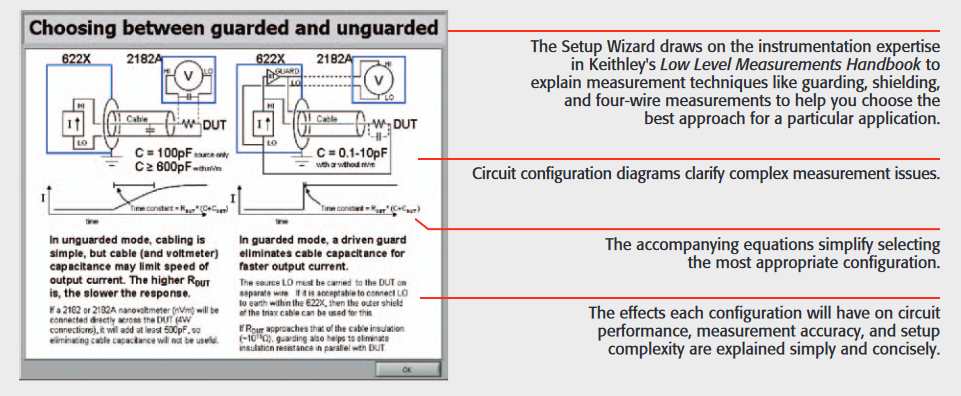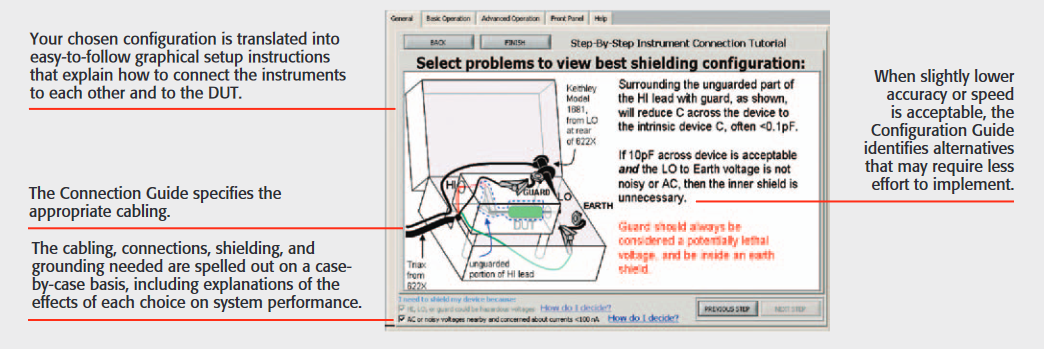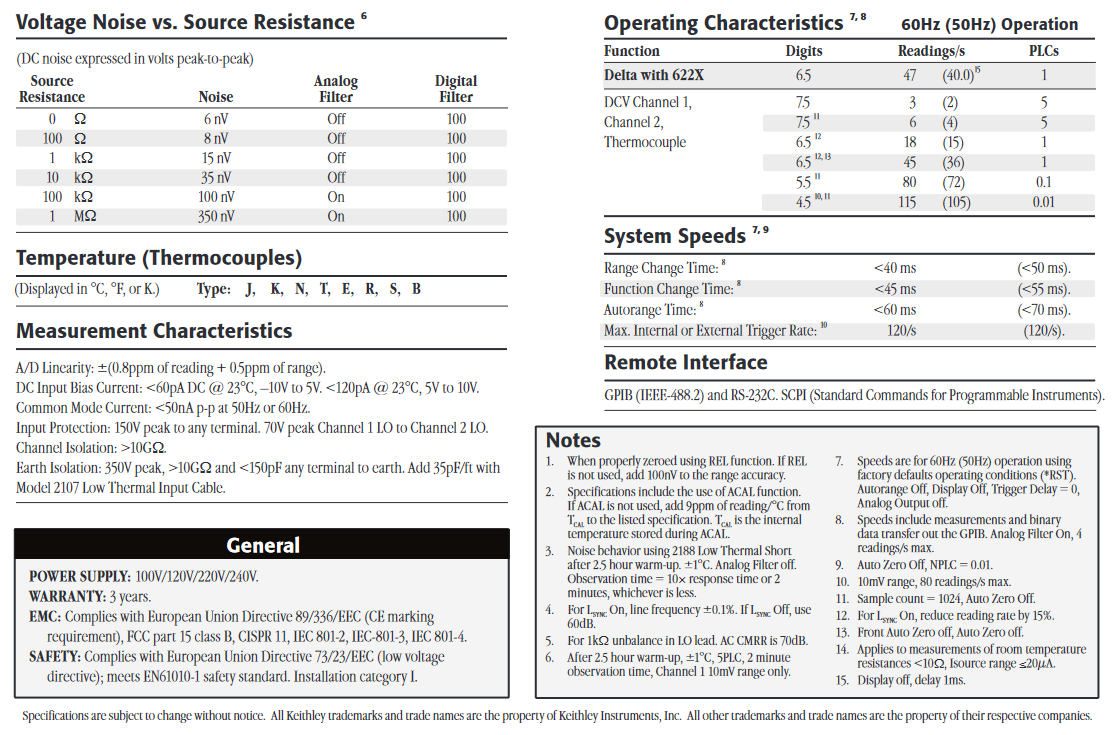High accuracy, low noise sourcing combined with exceptional ease of use
Keithley's new Model 6220 DC Current Source and Model 6221 AC and DC Current Source deliver the high resolution, low noise, low current sourcing you need to test and characterize today's tiny, fragile electronics.But just as important, we've made them easy to use.
Easy to configure, easy to operate
Built-in control functions like voltage compliance, sweep and waveform generation, and current pulsing, plus a choice of communication interfaces, help you integrate them readily into test systems. Free instrument control software walks you through connecting your instruments and programming basic sourcing functions. It even supports making delta mode resistance, differential conductance, and pulse mode measurements with the Model 2182A Nanovoltmeter. The software also makes it simple to create complex waveforms with the Model 6221's arbitrary waveform (ARB) function.
Have an existing application that uses Keithley's Model 220 or 224 current source? The emulation mode built into the Models 6220 and 6221 eliminates the need to reprogram your application, so you can get your system back up and running again quickly.
The problem with home-built sources
Think building your own current source is a good way to save on instrumentation? Think again. Unlike the Models 6220 and 6221, homebuilt current sources typically don't have a practical voltage compliance capability. That makes it extraordinarily difficult to limit the amount of voltage applied when sourcing a current, so it's all too easy to damage or destroy your device under test (DUT) accidentally. The current output of home-built sources is often unpredictable, but the Models 6220 and 6221 provide 1014Ω output impedance that ensures stable current sourcing into variable loads. Even if a home-built source can provide reasonably high output impedance, it still can't offer capabilities like AC sourcing, fast settling, or voltage compliance.
Why lock-in amplifiers and AC resistance bridges can't compete
When combined with a Model 2182A, the Model 6220 or 6221 will easily outperform resistance measurement solutions like AC resistance bridges and lock-in amplifiers, with lower noise, lower current sourcing ranges, lower voltage measurements, and less power dissipation-all at a lower cost. Unlike a lock-in amplifier, a 622X/2182A combination doesn't require the use of a voltage-to-current converter or a voltage preamplifier and is less susceptible to phase shift errors. The Model 6221 can even expand the capabilities of lock-in amplifiers in your existing applications-its clean signals and output synchronization signal make it an ideal source for use in applications such as measuring device response at the second and third harmonic.
What is a current source?
The characteristics of a quality current source include:

- High resolution
- A wide range of compliance settings
- Fast output settling
- Low noise
- High impedance output
Any power supply can deliver current to a device, but many of them simply set the output voltage and then supply as much current as the device can draw. However, in many cases, the best way to describe a device's behavior is as a function of the current that passes through it-not of the voltage across it. That means sourcing a set current is preferable to sourcing a set voltage. Constant current sources output a specified current through the DUT (device under test) and apply whatever voltage is required to force that current. Advanced current sources like the Model 6220 and 6221 allow you to set a "compliance limit" on the level of voltage applied.
High sourcing accuracy for greater measurement confidence
The Model 6220 and Model 6221 share most of the same functions and capabilities, but the Model 6221 adds AC current sourcing, waveform generation, and pulsing functions, as well as a built-in Ethernet interface.


Model 2182A The perfect measurement companion for the Model 6220 or 6221
The Model 2182A Nanovoltmeter is the natural measurement partner for either Model 622X current source for measuring resistance and creating I-V curves. While low voltage measurements are often associated with resistance measurements of highly conductive semiconductor materials and devices, they may also be required when measuring the resistance of non-conductive materials and components. Today's electronic components are extremely small, which means they usually have limited power handling capability.As a result, when electrically characterizing these components, it's critical to keep the test signals used small to prevent component breakdown or other damage. In resistance measurements, lower test currents produce lower and harder to measure-voltages across the devices. Linking the Model 2182A with a Model 622X Current Source makes it possible to address both of these challenges in one easy-to-use configuration.
The Model 2182A Nanovoltmeter combines low noise, thermoelectric EMF cancellation, fast measurement rates, and 2ppm accuracy to address demanding low voltage applications such as determining the electrical characteristics of power sensitive materials, highly conductive metals, and high and low temperature superconductors.
Whenever the Model 2182A and one of the current sources are operated together (as in the delta, differential conductance, or pulse modes), the current source configures the nanovoltmeter over the RS-232 interface, controls it through the Trigger Link interface, then retrieves the data for calculations over the RS-232 interface.


Support for complex measurement applications
Ultra-Low Power Resistance Measurements:Delta Mode
Characterizing the resistance of modern materials and components demands the ability to source very low current and measure very low voltages. Keithley's delta mode (current reversal) resistance measurement capability combines the low current DC sourcing capabilities of the Model 6220 or 6221 with the Model 2182A's low voltage measurement accuracy. This combination is ideal for making low resistance measurements (down to 10nΩ) for characterizing on-resistance, interconnects, superconductors, etc.
Even when the DUT is non-conductive, fragile devices can be damaged if too much power is applied, so sourcing very small currents and measuring the resulting low voltages is still critical.The delta mode function uses a current reversal and a three-point measurement algorithm to cancel the effects of thermoelectric EMFs and reduce measurement noise. Once the instruments are connected properly, starting the test is simply pressing the source's Delta button and then the Trigger button.

The delta mode automatically triggers the current source to alternate the signal polarity, and then triggers a nanovoltmeter reading at each polarity. These high speed current reversals cancel out both constant and drifting thermoelectric offsets, reducing measurement noise and increasing voltage and resistance measurement accuracy.
For more information on delta mode measurements, see the section titled "Lock-in amplifier replacement."
Low Power I-V Characterization:Pulsed Measurements

Although the delta mode technique reduces the power dissipated in the DUT by sourcing a lower level of current, some applications won't allow the use of reduced current in order to reduce power.For applications like these, such as I-V characterization of small, power-sensitive components, the Model 6221's high speed current pulsing capability reduces the average power dissipated in the DUT by reducing the time the current is applied, which minimizes device self-heating and prevents device damage. Both the Model 6221 and the Model 2182A have microsecond rise times on all ranges to allow taking a voltage measurement as soon as 16 microseconds after the current pulse is applied. The Model 2182A's sub-microsecond latency trigger allows the complete pulse-and-measure cycle to be as short as 50 microseconds. The 6221/2182A combination can make pulsed resistance and I-V measurements on devices ranging from 10nΩ to 100MΩ, so it's well suited for applications like superconductor, fuel cell, optoelectronics and nanotechnology research. Unlike other pulsed measurement solutions, it provides line synchronization to minimize 60Hz interference. It also incorporates the delta technique to eliminate voltage offsets and drift that can affect measurement accuracy.
High speed differential conductance measurements
Measuring differential conductance (also known as electron energy spectroscopy, tunneling spectroscopy, or simply dI/dV) is an important method for characterizing materials and components to reveal nonlinear material properties,such as density of states. It's widely used in nanotechnology, low temperature physics, and semiconductor research. The 622X/2182A combination measures differential conductance up to ten times faster than ever before. The Model 2182A's exceptional voltage sensitivity makes it possible to obtain data in a single pass, rather than by averaging the results of several measurement sweeps. The current source and the nanovoltmeter can be operated as a single instrument that can be controlled over the GPIB connection (or via Ethernet if the Model 6221 is used). This simple combo system offers significantly better performance than other approaches to differential conductance measurements, which typically require integrating from six to eight instruments and are often plagued by errors due to ground loops and common mode currents that flow between the various instruments.

Four-point resistivity, Hall measurement, conductivity type testing
In materials research and semiconductor manufacturing, resistivity measurements are critical. These measurements must be made using the four-wire "source current/measure voltage" method with the four probes in either the co-linear configuration or the van der Pauw configuration.When the resistivity or contact resistance is high (>100kΩ, which is typical of most semiconductor materials), the amount of applied current must be kept very small. Power limitations in the material often restrict the applied current still further, so the voltages to be measured will be smaller as well.The 622X/2182A combination brings together the low noise, low current sourcing and low noise voltage measurements necessary to meet these demanding requirements.

Adding a magnetic field to this same configuration allows measuring the material's Hall coefficient using the same four contacts. Using the delta mode for each of the measurements required makes special switch systems optimized for low offset voltage unnecessary,further simplifying the measurement.
The Model 6221's AC sourcing capability makes it easy to check the conductivity type of semiconductors, using the co-linear configuration.
Generate arbitrary current waveforms
Need to create a complex programmable load or sensor signal or to emulate signals or noise? It's easy to generate an unlimited variety of complex waveforms by adding, multiplying, joining, or filtering the standard wave shapes supplied with the Model 6221. You can program waveform repetition frequencies from 0.001Hz to 100kHz with an output update rate of 10 megasamples/second.Current waveforms can be used in many applications,such as dynamic loads used for power supply design or nerve impulse simulation.

Lock-in amplifier replacement
Lock-in amplifiers have long been used for some of the applications discussed in this brochure. When operated in delta mode, the 622X/2182A combination offers a variety of advantages over lock-in amplifiers. For example, the Models 6220 and 6221 are true current sources, so there's no need to make a measurement of the current through the device, which is required for confirmation when using a lock-in amplifier. The 622X/2182A combination can also make measurements with just half as much noise as a lock-in amplifier introduces. At or below the typical response frequency of the device/cabling combination, the 622X/2182A combination even provides better noise performance than lock-ins with external preamplifiers.

Built-in software support for advanced measurement functions
Measuring low level signals accurately often requires four point probing, guarding, or shielding techniques. However, these techniques can complicate the process of connecting instrumentation to the device under test (DUT). In most cases, though, there's no instrumentation specialist standing by to help you set up your test system. Fortunately, the free instrument control software provided with the Models 6220 and 6221 has a wealth of measurement knowledge built right into it. The Setup Wizard simplifies choosing the most appropriate measurement configuration for a specific application, while the Connection Guide provides detailed set-up instructions for the chosen configuration, including the cabling and test fixture. The software walks you through controlling basic sourcing functions, as well as delta mode resistance, differential conductance, and pulse mode measurements made with the Model 2182A. It collects data and displays results in intuitive formats. IVI-style (VISA based) instrument drivers are also provided for use with application development environments like LabVIEW® , LabWindowsTM/CVI, Visual Basic®, C/C++, and TestPoint™.
Setup Wizard guides you step-by-step through the configuration process

Connection Guide illustrates how to connect your chosen configuration

Condensed Specs: Models 6220/6221



Condensed Specs: Model 2182A Nanovoltmeter


Additional current sourcing solutions
Keithley offers a variety of alternatives if your application requires sourcing higher currents than the 100mA the Model 6220 or 6221 can deliver or demands additional measurement functions. Refer to the charts on page 2 for guidance on the ranges and other capabilities these instruments can provide.
Series 2400 SourceMeter® instruments offer higher current sourcing ranges (up to 10A), built-in voltage measurements, and Source V/Measure I configuration
For Hall voltage measurements on high resistance materials, the Model 4200-SCS Semiconductor Characterization System offers the convenience of low current sourcing, multiple channels of high impedance voltage measurement, and switching in one integrated box.
The Model 2520 Pulsed Laser Diode Test System offers faster pulsing than the Model 6221 (up to 500ns), faster measurements (streaming at 100ns), and higher current output (up to 5A).
For characterizing very high resistance devices (>100MΩ), the Model 6430 Sub-Femtoamp Remote SourceMeter® instrument or the Model 4200-SCS may offer a better solution than the Model 622X/2182A combination-they can also operate in Source Voltage/Measure Current mode, which can provide more detailed curves on high resistance samples.
Find more valuable resources at TEK.COM
Copyright © Tektronix. All rights reserved. Tektronix products are covered by U.S. and foreign patents, issu ed and pending. Information in this publication supersedes that in all previously published material. Specification and price change privileges reserved. TEKTRONIX and TEK are registered trademarks of Tektronix, Inc. All other trade names referenced are the service marks, trademarks or registered trademarks of their respective companies.
2588 010512.5KOP

